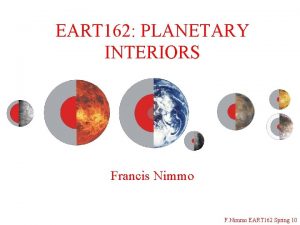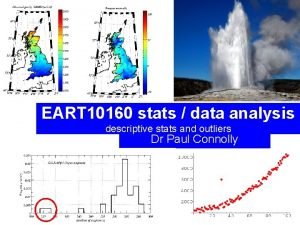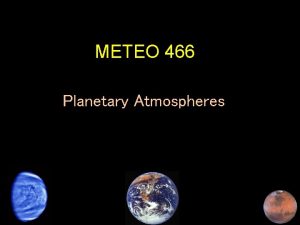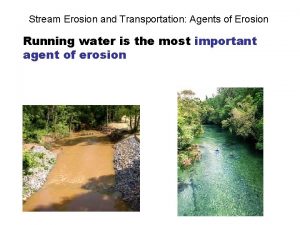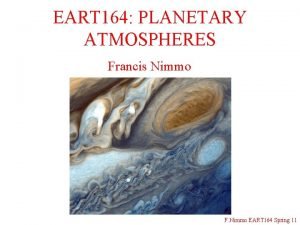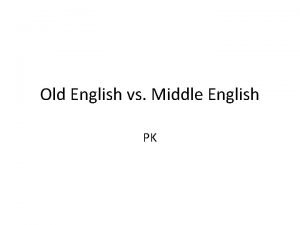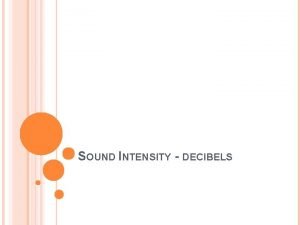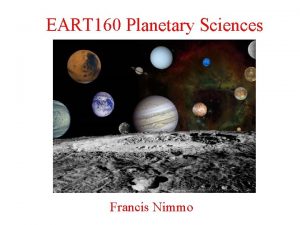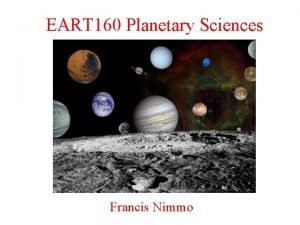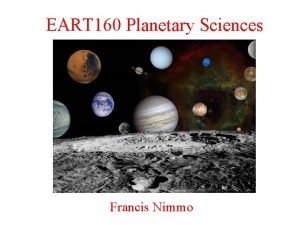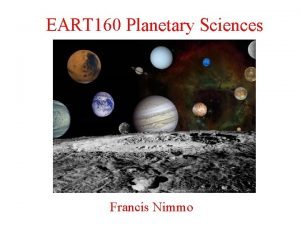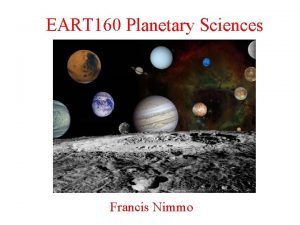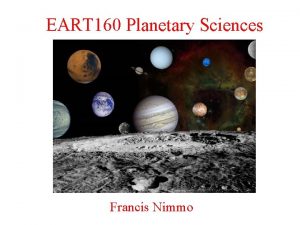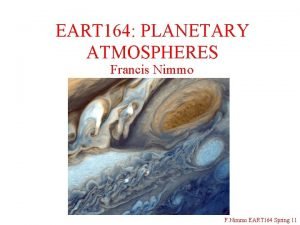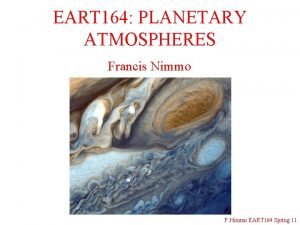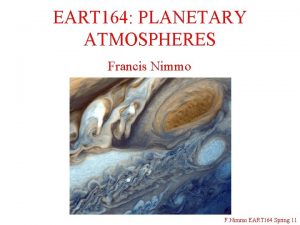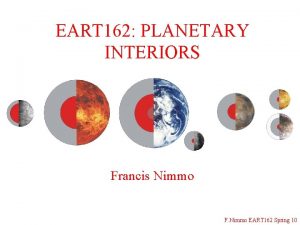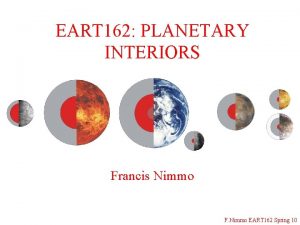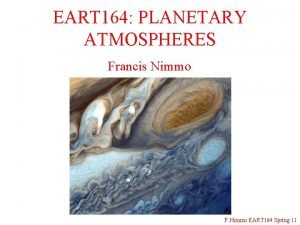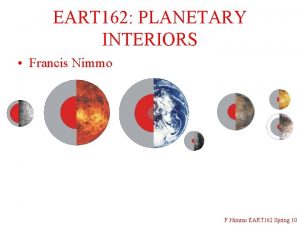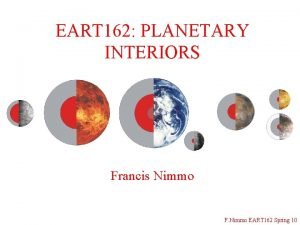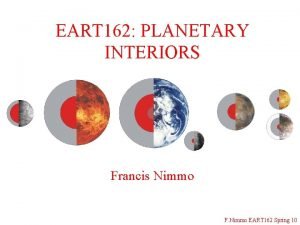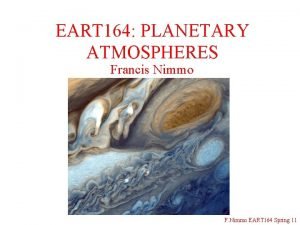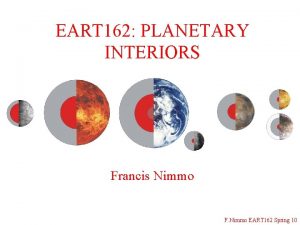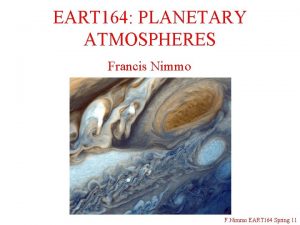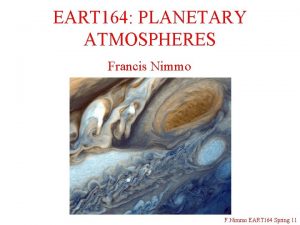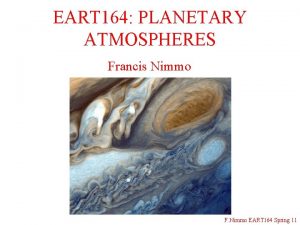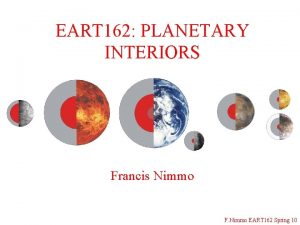EART 160 Planetary Sciences Francis Nimmo Last week


































- Slides: 34

EART 160 Planetary Sciences Francis Nimmo

Last week • Surface temperature depends on solar distance, albedo, atmosphere (greenhouse effect) • Scale height and lapse rate are controlled by bulk properties of atmosphere (and gravity) • Terrestrial planetary atmospheres are not primordial – affected by loss and outgassing • Coriolis effect organizes circulation into “cells” and is responsible for bands seen on giant planets • [Isotopic fractionation is a good signal of atmospheric loss due to Jeans escape • Significant volatile quantities may be present in the interiors of terrestrial planets]

Giant Planets • • • What determines their internal structure? How did they form and evolve? What controls their atmospheric dynamics? (Week 5) What about extra-solar planets? Rings not discussed

Giant Planets Image not to scale!

Basic Parameters a (AU) Porb (yrs) Prot (hrs) R (km) M (1026 kg) Obliquity Density g/cc Ts K Jupiter 5. 2 11. 8 9. 9 71492 19. 0 3. 1 o 1. 33 165 Saturn 9. 6 29. 4 10. 6 60268 5. 7 26. 7 o 0. 69 134 Uranus 19. 2 84. 1 17. 2 R 24973 0. 86 97. 9 o 1. 32 76 Neptune 30. 1 165 16. 1 24764 1. 02 29. 6 o 1. 64 72 Data from Lodders and Fegley 1998. Surface temperature Ts and radius R are measured at 1 bar level.

Compositions (1) • We’ll discuss in more detail later, but briefly: – (Surface) compositions based mainly on spectroscopy – Interior composition relies on a combination of models and inferences of density structure from observations – We expect the basic starting materials to be similar to the composition of the original solar nebula • Surface atmospheres dominated by H 2 or He: Solar Jupiter Saturn Uranus H 2 83. 3% 86. 2% 96. 3% 82. 5% He 16. 7% 13. 6% 3. 3% Neptune 80% 15. 2% 19% (2. 3% CH 4) (1% CH 4) (Lodders and Fegley 1998)

Pressure • Hydrostatic approximation • Mass-density relation • These two can be combined (how? ) to get the pressure at the centre of a uniform body Pc: • Jupiter Pc=7 Mbar, Saturn Pc=1. 3 Mbar, U/N Pc=0. 9 Mbar • This expression is only approximate (why? ) (estimated true central pressures are 70 Mbar, 42 Mbar, 7 Mbar) • But it gives us a good idea of the orders of magnitude involved

Temperature • We discussed this issue last week • If a packet of gas rises rapidly (adiabatic), then it will expand and, as a result, cool • Work done in expanding = work done in cooling m is the mass of one mole, r is the density of the gas Cp is the specific heat capacity of the gas at constant pressure • Combining these two equations with hydrostatic equilibrium, we get the dry adiabatic lapse rate: a • At 1 bar level on Jupiter, T=165 K, g=23 ms-2, Cp~3 R/m, m=0. 002 kg (H 2), so d. T/dz = 1. 8 K/km (adiabatic)

Hydrogen phase diagram Hydrogen undergoes a phase change at ~100 GPa to metallic hydrogen (conductive) It is also theorized that He may be insoluble in metallic H. This has implications for Saturn. Interior temperatures are adiabats • Jupiter – interior mostly metallic hydrogen • Saturn – some metallic hydrogen • Uranus/Neptune – molecular hydrogen only

Compressibility & Density Con stan t de nsit y radius mass • As mass increases, radius also increases • But beyond a certain mass, radius decreases as mass increases. • This is because the increasing pressure compresses the deeper material enough that the overall density increases faster than the mass • The observed masses and radii are consistent with a mixture of mainly H+He (J, S) or H/He+ice (U, N)

From Guillot, 2004

Magnetic fields

• • How are they generated? Dynamos require convection in a conductive medium Jupiter/Saturn – metallic hydrogen (deep) Uranus/Neptune - near-surface convecting ices (? ) The near-surface convection explains why higher-order terms are more obvious – how? (see Stanley and Bloxham, Nature 2004)

Summary • Jupiter - mainly metallic hydrogen. Rock-ice core ~10 ME. • Saturn - mix of metallic and molecular hydrogen; helium may have migrated to centre due to insolubility. Similar rock-ice core to Jupiter. Mean density lower than Jupiter because of smaller selfcompression effect (pressures lower). • Uranus/Neptune – thin envelope of hydrogen gas. Pressures too low to generate metallic hydrogen. Densities (and moment of inertia data) require large rock-ice cores in the interior. • All four planets have large magnetic fields, presumably generated by convection in either metallic hydrogen (J, S) or conductive ices (U, N)

Giant Planet Formation (see Week 1) • Initially solid bodies (rock + ice; beyond snow line) • When solid mass exceeded ~10 Me, gravitational acceleration sufficient to trap an envelope of H and He • Process accelerated until nebular gas was lost • So initial accretion was rapid (few Myr) • Uranus and Neptune didn’t acquire so much gas because they were further out and accreted more slowly • Planets will have initially been hot (gravitational energy) and subsequently cooled and contracted • We can investigate how rapidly they are cooling at the present day. . .

Energy budget observations • Incident solar radiation much less than that at Earth • So surface temperatures are lower • We can compare the amount of solar energy absorbed with that emitted. It turns out that there is usually an excess. Why? All units in After Hubbard, in New Solar System (1999) 1. 4 W/m 2 reflected 48 3. 5 14 incident 8. 1 5. 4 Jupiter 0. 6 4. 6 13. 5 2. 6 0. 3 2. 0 Saturn 0. 3 Uranus Neptune

Sources of Energy • One major one is contraction – gravitational energy converts to thermal energy. Helium sinking is another. • Gravitational energy of a uniform sphere is Where does this come from? • So the rate of energy release during contraction is e. g. Jupiter is radiating 3. 5 x 1017 W in excess of incident solar radiation. This implies it is contracting at a rate of 0. 4 km / million years • Another possibility is tidal dissipation in the interior. This turns out to be small. • Radioactive decay is a minor contributor.

Puzzles • Why is Uranus’ heat budget so different? – Perhaps due to compositional density differences inhibiting convection at levels deeper than ~0. 6 Rp. May explain different abundances in HCN, CO between Uranus and Neptune atmospheres. – This story is also consistent with generation of magnetic fields in the near-surface region (see earlier slide) • Why is Uranus tilted on its side? – Nobody really knows, but a possible explanation is an oblique impact with a large planetesimal (c. f. Earth-Moon) – This impact might even help to explain the compositional gradients which (possibly) explain Uranus’ heat budget

Atmospheric Structure (1) • Atmosphere is hydrostatic: • Gas law gives us: • Combining these two (and neglecting latent heat): Here R is the gas constant, m is the mass of one mole, and RT/gm is the scale height of the (isothermal) atmosphere (~10 km) which tells you how rapidly pressure increases with depth

Atmospheric Structure (2) • Lower atmosphere (opaque) is dominantly heated from below and will be conductive or convective (adiabatic) • Upper atmosphere intercepts solar radiation and re-radiates it • There will be a temperature minimum where radiative cooling is most efficient; in giant planets, it occurs at ~0. 1 bar • Condensation of species will occur mainly in lower atmosphere mesosphere radiation Temperature (schematic) Theoretical cloud distribution CH 4 (U, N only) stratosphere tropopause ~0. 1 bar NH 3 clouds troposphere adiabat NH 3+H 2 S H 2 O 80 K 140 K 230 K 270 K

Giant planet atmospheric structure • Note position and order of cloud decks

Extra-Solar Planets • • A very fast-moving topic How do we detect them? What are they like? Are they what we would have expected? (No!)

How do we detect them? • The key to most methods is that the star will move (around the system’s centre of mass) in a detectable fashion if the planet is big and close enough • 1) Pulsar Timing A pulsar is a very accurate clock; but there will be a variable time-delay introduced by the motion of the pulsar, which will be detected as a variation in the pulse rate at Earth pulsar planet Earth • 2) Radial Velocity Spectral lines in star will be Doppler-shifted by component of velocity of star which is in Earth’s line-of-sight. This is easily the most common way of detecting ESP’s. Earth star planet

How do we detect them? (2) • 2) Radial Velocity (cont’d) The radial velocity amplitude is given by Kepler’s laws and is Earth i Does this make sense? Ms Mp Note that the planet’s mass is uncertain by a factor of sin i. The Ms+Mp term arises because the star is orbiting the centre of mass of the system. Present-day instrumental sensitivity is about 3 m/s; Jupiter’s effect on the Sun is to perturb it by about 12 m/s. From Lissauer and Depater, Planetary Sciences, 2001

How do we detect them? (3) • 3) Occultation (transit) Planet passes directly in front of star. Very rare, but very useful because we can: 1) Obtain M (not M sin i) 2) Obtain the planetary radius 3) Obtain the planet’s spectrum (!) About a dozen examples to date. Light curve during occultation of HD 209458. From Lissauer and Depater, Planetary Sciences, 2001 • 4) Astrometry Not yet demonstrated. • 5) Microlensing Ditto. • 6) Direct Imaging. Yes! But can’t determine masses. . .

What are they like? • Big, close, and often highly eccentric – “hot Jupiters” • What are the observational biases? Note the absence of high eccentricities at close distances – what is causing this effect? HD 209458 b is at 0. 045 AU from its star and seems to have a radius which is too large for its mass (0. 7 Mj). Why? Jupiter Saturn From Guillot, Physics Today, 2004

What are they like (2)? • Several pairs of planets have been observed, often in 2: 1 resonances • (Detectable) planets seem to be more common in stars which have higher proportions of “metals” (i. e. everything except H and He) There also claims that HD 179949 has a planet with a magnetic field which is dragging a sunspot around the surface of the star. . . From Lissauer and Depater, Planetary Sciences, 2001 Sun Mean local value of metallicity

Exoplanet atmospheres • Two classes of atmospheres (depending on Ti, V absorption) Laughlin et al. 2009 • Shorter time constant than Earth’s stratosphere (few hours vs. few days) Fortney et al. 2008

Puzzles • 1) Why so close? – Most likely explanation seems to be inwards migration due to presence of nebular gas disk (which then dissipated) – The reason they didn’t just fall into the star is because the disk is absent very close in, probably because it gets cleared away by the star’s magnetic field. An alternative is that tidal torques from the star (just like the Earth-Moon system) counteract the inwards motion • 2) Why the high eccentricities? – No-one seems to know. Maybe a consequence of scattering off other planets during inwards migration? • 3) How typical is our own solar system? – Not very, on current evidence

Consequences • What are the consequences of a Jupiter-size planet migrating inwards? (c. f. Triton) • Systems with hot Jupiters are likely to be lacking any other large bodies • So the timing of gas dissipation is crucial to the eventual appearance of the planetary system (and the possibility of habitable planets. . . ) • What controls the timing? • Gas dissipation is caused when the star enters the energetic T-Tauri phase – not well understood (? ) • So the evolution (and habitability) of planetary systems is controlled by stellar evolution timescales – hooray for astrobiology!

Summary • Giant planets primarily composed of H, He with a ~10 Me rock-ice core which accreted first • They radiate more energy than they receive due to gravitational contraction (except Uranus!) • Clouds occur in the troposphere and are layered according to condensation temperature • Many (~300) extra-solar giant planets known • Many are close to the star or have high eccentricities – very unlike our own solar system • Nebular gas probably produced inwards migration

Key concepts • • Adiabat, lapse rate, scale height Hydrogen phase diagram Hydrostatic assumption Compressibility, mass-radius relationship Gravitational contraction Radial velocity Inwards migration Orbital circularization

End of lecture

Temperature (2) • At 1 bar level on Jupiter, T=165 K, g=23 ms-2, Cp~3 R, m=0. 002 kg (H 2), so d. T/dz = 1. 4 K/km (adiabatic) • We can also use the expressions on the previous page to derive how the adiabatic temperature varies with pressure a (Here T 0, P 0 are reference temp. and pressure, and c is constant defined on previous slide) This is an example of adiabatic temperature and density profiles for the upper portion of Jupiter, using the same values as above, keeping g constant and assuming g=1. 5 Note that density increases more rapidly than temperature – why? Slope determined by g
 Francis nimmo
Francis nimmo Jennifer nimmo
Jennifer nimmo Eart cuff
Eart cuff Googol eart
Googol eart How to plot
How to plot Madebyevan com webgl water
Madebyevan com webgl water Genesis 11 1-9 nkjv
Genesis 11 1-9 nkjv Meteo eart
Meteo eart Eart
Eart Eart
Eart Fæder ure þu þe eart on heofonum
Fæder ure þu þe eart on heofonum Natural sciences tok
Natural sciences tok Week by week plans for documenting children's development
Week by week plans for documenting children's development Last week of lent
Last week of lent What was the weather like last week
What was the weather like last week Tom wasn't/weren't at school last week
Tom wasn't/weren't at school last week Your last summer holiday
Your last summer holiday Last week we installed a kitty door
Last week we installed a kitty door Window was broken
Window was broken Weekend
Weekend Last week's homework
Last week's homework Did you do your homework yesterday?
Did you do your homework yesterday? Last week
Last week Last week summary
Last week summary Did you play football yesterday?
Did you play football yesterday? Last week tuesday
Last week tuesday Last week in japanese
Last week in japanese What did you last weekend
What did you last weekend Last week's lesson
Last week's lesson If the books have been cataloged
If the books have been cataloged Writing about my friend birthday party
Writing about my friend birthday party The doctor gave me a for some medicine last week
The doctor gave me a for some medicine last week Watched past simple
Watched past simple Recap from last week
Recap from last week What did you last week
What did you last week
